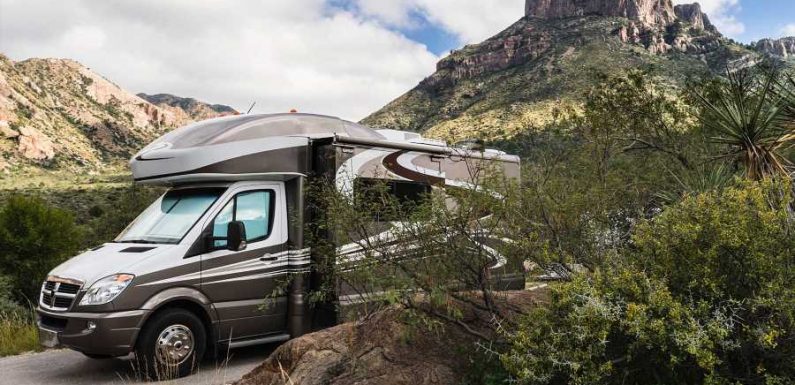
Editor's Note: Those who choose to travel are strongly encouraged to check local government restrictions, rules, and safety measures related to COVID-19 and take personal comfort levels and health conditions into consideration before departure.
Big Bend National Park has it all — vast amounts of open space, rivers, canyons, pictographs, and hot springs. Located in southwest Texas, the park can be wonderfully warm in the winter and unbearably hot in the summer, offering year-round access to some of the most beautiful terrain in the state. Big Bend National Park is where the Chihuahuan Desert meets the Chisos Mountains, and it's where you'll find the Santa Elena Canyon, a limestone cliff canyon artfully carved by the Rio Grande.
Thanks to the park's varied terrain, you can choose between desert, mountain, and river hikes, or hop in your car and explore the park on four wheels. Those looking to cool off from the summer heat can book a multi-day trip down the Rio Grande or find a shady spot and try their hand at bird watching (Northern Cardinal, Green Heron, and Green Kingfisher birds all frequent the park).
When night falls, you'll want to have an already reserved campsite so all you have to do is settle in and look up — Big Bend National Park is said to have the least amount of light pollution of any other national park in the lower 48, making it a go-to destination for stargazers. Here's everything you need to know to secure that perfect Big Bend National Park camping spot.
Campgrounds in Big Bend National Park
There are four campgrounds inside Big Bend National Park — three park-operated camping areas with various services and one RV park run by an outside company. The three park-run campgrounds are Chisos Basin Campground, Rio Grande Village Campground, and Cottonwood Campground. All require advance reservations booked (up to 6 months in advance) through recreation.gov or by calling 877-444-6777.
Chisos Basin Campground sits in a scenic mountain basin with views of Casa Grande and Emory Peak. There are plenty of hiking trails nearby, including Window Trail, a popular place to watch the sunset. The year-round campground has 60 sites with access to flush toilets, running water, and a dump station. There are no hook-ups, and trailers over 20 feet and RVs over 24 feet are not recommended.
The year-round Rio Grande Village Campground is nestled in a grove of trees near the Rio Grande. This is the place to go if you want access to more amenities — a store, laundromat, and visitor center are nearby. The park has 100 sites with access to flush toilets, running water, showers, and some sites with overhead shelters. A dump station is nearby.
The small Cottonwood Campground is more remote than the other campgrounds and has fewer services, but tends to be quieter, with plenty of shade. Cottonwood is a seasonal campground (open November 1 to April 30) with 24 camp spots — all without hook-ups or generators.
Big Bend National Park RV Camping
While certain park-operated campgrounds allow RVs, you'll want to head to the Rio Grande Village RV Park (operated by Forever Resorts) for a camping experience tailored to RV campers.
All 25 sites at Rio Grande Village have full hook-ups — water, electrical, and sewer — and are built for RVs. (Keep in mind a few sites cannot accommodate rigs 40 feet or longer.) The campground sits adjacent to the Rio Grande Village Store and allows pets. For reservations, call 432-477-2293.
Backcountry Camping in Big Bend National Park
Big Bend National Park has plenty of vast open space, making it perfect for those willing to get off the beaten path and try their hand at primitive backcountry camping. Inside the park, you'll find roadside campsites (great for car camping) as well as rugged spots for backpackers or those on a river or horseback riding trip.
Before you head into the park's open space, make sure you've secured the proper backcountry permit. Permits for designated backcountry sites (like the Chisos Backpacking Campsites and most roadside campsites) are available online at recreation.gov, while permits for backcountry camping and roadside sites along Maverick and River Roads must be secured in-person at either the Panther Junction Visitor Center or Chisos Basin Visitor Center.
Big Bend National Park Camping Regulations
Reservations are required for Chisos Basin Campground, Rio Grande Village Campground, and Cottonwood Campground, and they're highly recommended for Rio Grande Village RV Park (20 of the 25 sites must be reserved in advance). Reservations can be made up to 6 months (180 days) in advance and can be made for up to 14 consecutive nights.
Chisos Basin Campground and the Rio Grande Village RV Park operate at full capacity year-round, while Rio Grande Village Campground limits capacity and Cottonwood Campground closes during the heat of summer (May 1 to October 31).
Tips for Camping in Big Bend National Park
All the campgrounds inside the park tend to fill up quickly, so making an advance reservation is key, especially during the busy season: January 1 through April 15. In addition, winter holidays — Thanksgiving, Christmas, New Years, and Texas spring break — tend to be popular times to visit the park.
If you're looking for a quieter camping experience within the park, head to Cottonwood Campground or look into one of the more primitive backcountry options. There are also campgrounds outside (but nearby) Big Bend National Park.
Source: Read Full Article












